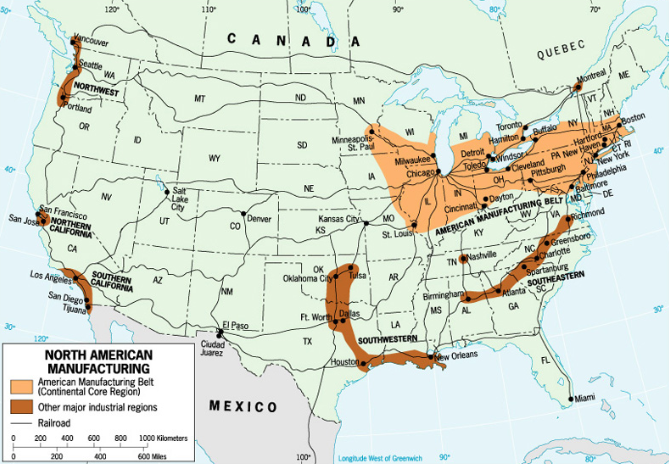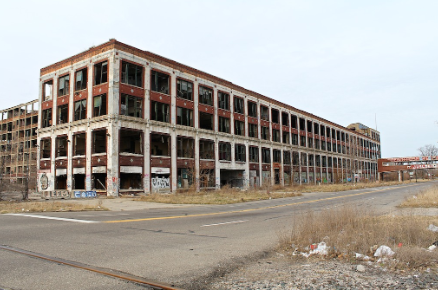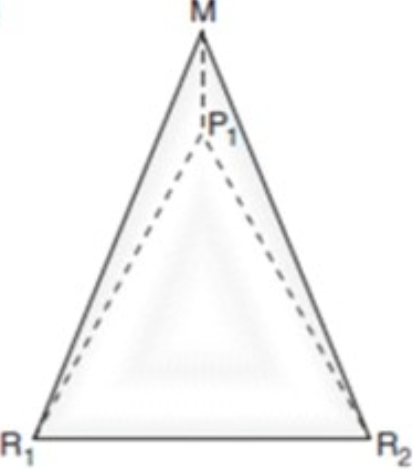Chapter 11 Service and Industry Topics
==Deindustrialization==
]]Define]]
Deindustrialization is when companies move industrial jobs to other regions

{{Example{{
Great Lakes
The manufacturing belt in the Great Lakes region turned to the rust belt as secondary industrial activity was moved to the Sunbelt and Northwest

Deindustrialization in the Great Lakes regions happened because of
- cheaper labor in the South (less skilled workers or less strong unions)
- looser labor and environmental regulations in the South
- decreased global demand for goods (Marshall Plan - as other places industrialized, U.S. factories shut down because they weren’t needed)
- Europe, SE Asia, E Asia, Japan, China, Singapore, Taiwan, S. Korea
- more machines in the G.L. region leading to less need for workers
https://www.youtube.com/watch?v=HfASWPpeZLE
Youngstown
Deindustrialization also occurred in Youngstown, Ohio
https://www.youtube.com/watch?v=IKuGNt1w0tA
After the steel mill closed in the 1970s, it turned into a brownfield
- abandoned homes
- 80% pop decrease
- lost 40,000 jobs
- 1/4 of Idora neighborhood vacant
- 137 homes there demolished
- 8.8% unemployment
- $30k homes
In turn, Youngstown redeveloped
- rebuilt as a college town
- switch to tertiary activity
- attract tech startup
- 400 new jobs
- 3D printing
}}Effects}}
The deindustrialized region switches to tertiary economic activities, works through unemployment, and may see brownfields
However, new industrial belts are created
Brownfields are sites of abandoned factories and vacant resident homes
old, torn down, vacant, residents lose jobs and move, environmental concerns, new people move in → crime

<<Locational Criteria<<
388-394 in textbook
- Site features
- Land
- Labor
- Capital
- Situation features
- In relation to other places
- Variable costs
- Energy
- Transportation
- Resources
- Friction of distance: increased distance = increased time and costs
Industrialization’s heath was in Great Britain because of locational criteria
- rivers, port city, ocean access, coal, highways
- regional/global trade, colony resources
- high wages incentivized the switch to machines
==Weber’s Least Cost Theory==
]]Costs]]
Transportation - the lowest possible cost of:
- raw materials to the factory
- finished products to the market
Labor
- high labor reduces profits, so a factory might do better with cheap labor
Agglomeration
- shared talents, services, and facilities
{{Bulk Gaining{{
The finished product weighs more than resources (beer, computers)
Because the resources are lighter, they are cheaper to transport and the finished product will be more expensive to transport
The factory will be closer to the market than the resources so the heavy finished products don’t have to travel far

}}Bulk Reducing}}
The finished product weighs less than resources (copper, paper)
Because the finished products are lighter, they are cheaper to transport and the resources will be more expensive to transport
The factory will be closer to the resources than the market so the heavy resources don’t have to travel far

==Economic Sectors==
]]Primary]]
Getting raw materials
- Growing chickens, planting trees, fishing, lumber, coal mining
{{Secondary{{
Processing raw materials into finished products
- Manufacturing, construction, processing
}}Tertiary}}
Activities or services that move, sell, or trade products
Retain and wholesale trade, bank teller, carpet cleaners, fast food workers, teachers, urban planners, hairdressers
Producer- services performed for corporations
- Finance, insurance, real estate, legal, accounting
Consumer- services performed for individuals
- Entertainment, tourism, restaurants, education, health care
Geography based on market access rather than energy
Quaternary
Information creation and transfer (a subset of tertiary)
- information, research, management investment analysts, university reseachesers
Quinary
Highest level of decision-making (a subset of tertiary)
- legislative, presidential cabinet, high-level government work
Tourism
- Tourism- travel taken for recreation rather than business.
- Most important tertiary activity
- World’s largest private industry in jobs and total value generated.
- 10 % world’s GDP
- Half of world’s poorest 50 countries, leading service export sector.
<<Labor Force<<

Other Resources
Chapter 11 Vocab
https://knowt.io/flashcards/057d1997-e7fc-4572-8d17-261f4d72dec6
Previously Released FRQs
2019 Set 2 Question 1 - Deindustrialization
Prompt Page 2
https://apcentral.collegeboard.org/media/pdf/ap19-frq-human-geography-set-2.pdf
Rubric Pages 2-3
https://apcentral.collegeboard.org/media/pdf/ap19-sg-human-geography-set-2_1.pdf
2016 Question 1 - Development and Economic Sectors
Prompt Page 2
https://secure-media.collegeboard.org/digitalServices/pdf/ap/ap16frqhuman_geography.pdf
Rubric Pages 2-3
https://secure-media.collegeboard.org/digitalServices/pdf/ap/ap16humangeography_sg.pdf
2013 Question 1 - Agglomeration
Prompt Page 2
https://secure-media.collegeboard.org/digitalServices/pdf/ap/apcentral/ap13frqhuman_geography.pdf
Rubric Pages 2-3